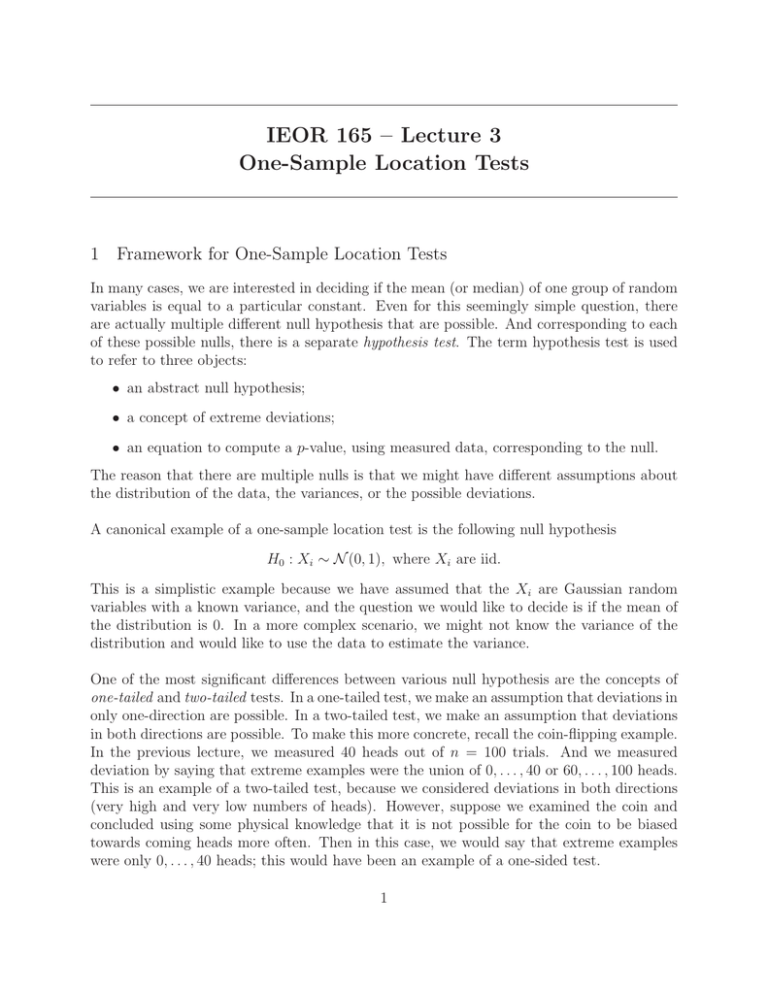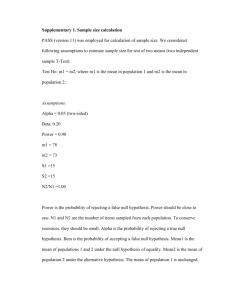IEOR 165 – Lecture 3 One-Sample Location Tests
advertisement

IEOR 165 – Lecture 3
One-Sample Location Tests
1 Framework for One-Sample Location Tests
In many cases, we are interested in deciding if the mean (or median) of one group of random
variables is equal to a particular constant. Even for this seemingly simple question, there
are actually multiple different null hypothesis that are possible. And corresponding to each
of these possible nulls, there is a separate hypothesis test. The term hypothesis test is used
to refer to three objects:
• an abstract null hypothesis;
• a concept of extreme deviations;
• an equation to compute a p-value, using measured data, corresponding to the null.
The reason that there are multiple nulls is that we might have different assumptions about
the distribution of the data, the variances, or the possible deviations.
A canonical example of a one-sample location test is the following null hypothesis
H0 : Xi ∼ N (0, 1), where Xi are iid.
This is a simplistic example because we have assumed that the Xi are Gaussian random
variables with a known variance, and the question we would like to decide is if the mean of
the distribution is 0. In a more complex scenario, we might not know the variance of the
distribution and would like to use the data to estimate the variance.
One of the most significant differences between various null hypothesis are the concepts of
one-tailed and two-tailed tests. In a one-tailed test, we make an assumption that deviations in
only one-direction are possible. In a two-tailed test, we make an assumption that deviations
in both directions are possible. To make this more concrete, recall the coin-flipping example.
In the previous lecture, we measured 40 heads out of n = 100 trials. And we measured
deviation by saying that extreme examples were the union of 0, . . . , 40 or 60, . . . , 100 heads.
This is an example of a two-tailed test, because we considered deviations in both directions
(very high and very low numbers of heads). However, suppose we examined the coin and
concluded using some physical knowledge that it is not possible for the coin to be biased
towards coming heads more often. Then in this case, we would say that extreme examples
were only 0, . . . , 40 heads; this would have been an example of a one-sided test.
1
2 One-Sample Gaussian Tests
Suppose the null hypothesis is
H0 : Xi ∼ N (µ, σ 2 ), where Xi are iid,
and µ and σ 2 are known constants. There are three possible concepts of extreme deviations,
each with a corresponding equation. If Z ∼ N (0, 1), then the three tests are
• One-Tailed with Only Deviations Below µ Possible:
!
√ X − µ
p=P Z < n·
σ
• One-Tailed with Only Deviations Above µ Possible:
!
√ X − µ
p=P Z > n·
σ
• Two-Tailed Deviations Possible:
p = P |Z| >
√
!
X − µ
n·
σ
The intuition behind
these tests is that, by the properties of iid Gaussian distributions, we
√
know that (σ/ n) · Z + µ has distribution N (µ, σ 2 /n). And so these tests are looking at the
probability we would see something as (or more) extreme than X, which by the properties
of iid Gaussians has distribution N (µ, σ 2 /n). As for computation of the p-values, we can get
these values using a calculator/computer or using a standard Z-table.
This test is sometimes used even if the distribution in the null hypothesis
√ is not Gaussian. The reason is the central limit theorem says that the distribution of n(X − E(Xi ))
converges in distribution to that of N (0, σ 2 ). And so if we have a large amount of data
(n = 30 is common rule of thumb, though the meaning of “large” depends on how skewed
the distribution of the null hypothesis is) then we can approximate the p-value using this
test.
3 One-Sample Hoeffding Tests
Suppose the null hypothesis is
H0 : Xi ∈ [a, b] and E(Xi ) = µ, where Xi are iid,
and a, b, µ are known constants. Recall that the notation Xi ∈ [a, b] means that a ≤ Xi ≤ b,
and note that this does not necessarily mean that the Xi are uniformly distributed. A
uniform distribution is a special case of this null hypothesis, but more general hypothesis are
possible. There are three possible concepts of extreme deviations, each with a corresponding
equation. The three tests are
2
• One-Tailed with Only Deviations Below µ Possible:
!
2
exp −2n·(X−µ) , if X < µ
(b−a)2
p≤
1,
otherwise
• One-Tailed with Only Deviations Above µ Possible:
!
2
exp −2n·(X−µ) , if X > µ
(b−a)2
p≤
1,
otherwise
• Two-Tailed Deviations Possible:
p ≤ 2 exp
−2n · (X − µ)2
(b − a)2
!
The intuition behind these tests is that bounded distributions satisfy Hoeffding’s inequality.
The two-sided variant of this inequality is that
!
!
2
−2nt
P X − µ > t ≤ 2 exp
.
(b − a)2
A key thing to note about this test is that the equations give upper bounds on the pvalue, which are used to make decisions. The reason for using upper bounds on the p-value to
make decisions is that this makes the test more stringent by biasing us towards accepting the
null hypothesis, since the values are larger. In cases where it is difficult to exactly compute
the p-value, it is common to use upper bounds on the p-value to make decisions.
4 One-Sample t-Test
The Student’s t distribution is the distribution of the random variable t defined as
Z
t= p
,
V /ν
where Z ∼ N (0, 1), V ∼ χ2ν has a chi-squared distribution with ν degrees of freedom, and
Z, V are independent. Now suppose the null hypothesis is
H0 : Xi ∼ N (µ, σ 2 ), where Xi are iid,
3
and µ is a known constant, but σ 2 is an unknown constant. There are three possible concepts
of extreme deviations, each with a corresponding equation. If t is a Student’s t distribution
with n − 1 degrees of freedom, and
n
1 X
(Xi − X)2 ,
s =
n − 1 i=1
2
then the three tests are
• One-Tailed with Only Deviations Below µ Possible:
X − µ
√
p=P t<
s/ n
!
• One-Tailed with Only Deviations Above µ Possible:
X − µ
√
p=P t>
s/ n
!
• Two-Tailed Deviations Possible:
X − µ
p = P |t| > √ s/ n
!
The intuition behind these tests is that we have n − 1 degrees of freedom because we are
using the sample mean X in our estimate of the sample variance s2 . As for computation
of the p-values, we can get these values using a calculator/computer or using a standard
t-table.
This test is sometimes used even if the distribution in the null hypothesis
is not Gaussian.
√
The reason is the central limit theorem says that the distribution of n(X −E(Xi )) converges
in distribution to that of N (0, σ 2 ), and the weak law of large numbers says √
that s2 converges
in probability to σ 2 . And so Slutsky’s theorem implies that (X − µ)/(s/ n) converges in
distribution to N (0, 1). So if we have a large amount of data (n = 30 is common rule of
thumb, though the meaning of “large” depends on how skewed the distribution of the null
hypothesis is) then we can approximate the p-value using this test.
5 One-Sample Sign Test
Suppose the null hypothesis is
H0 : median(Xi ) = m, where Xi are iid,
and m is a known constant. There are three possible concepts of extreme deviations, each
with a corresponding equation. If W is the number of measurements that are larger than
m, then the three tests are
4
• One-Tailed with Only Deviations Below m Possible:
X n
0.5k · 0.5n−k
p1 =
k
k∈{0,...,W }
• One-Tailed with Only Deviations Above m Possible:
X n
0.5k · 0.5n−k
p2 =
k
k∈{W,...,n}
• Two-Tailed Deviations Possible:
p3 = 2 min{p1 , p2 }
The intuition behind these tests is that W follows a binomial distribution.
This is an example of what is known as a nonparametric test. The reason for this
name is that the null hypothesis is fairly broad, and it does not depend upon the particular
distribution. This is in contrast to say the t-test, in which the null hypothesis specifies that
the data is generated by a Gaussian distribution with known mean but an unknown variance
parameter. The t-test, Gaussian test, and Hoeffding test are parametric tests because they
depend on a small number of parameters.
5






